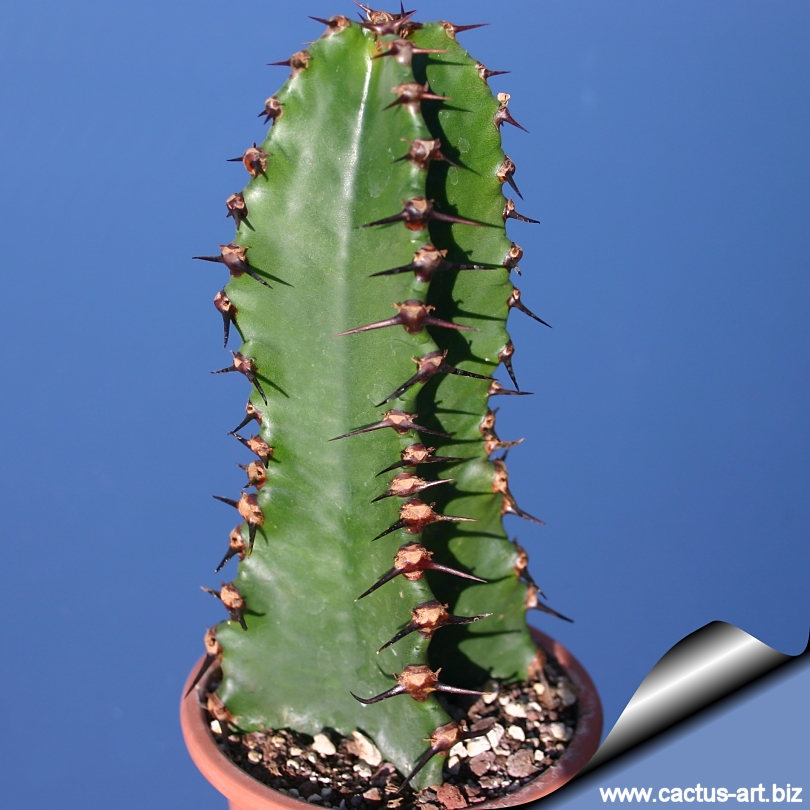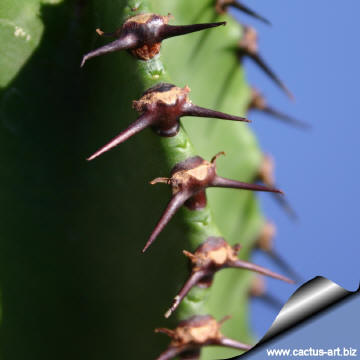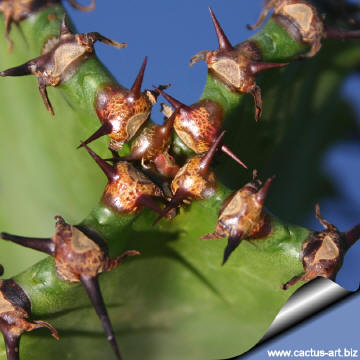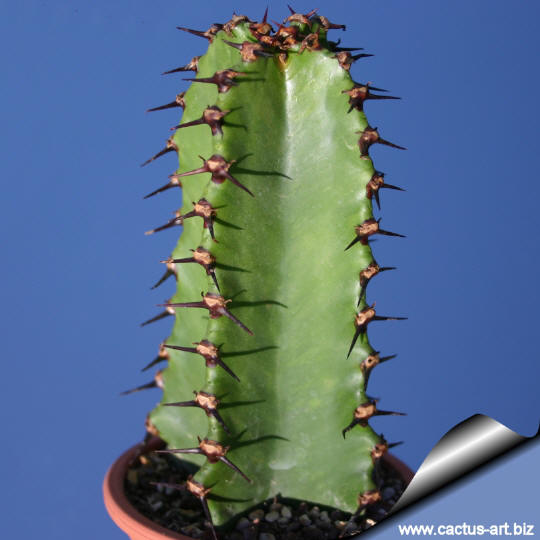|
|
|

Euphorbia
ammak
This is a very showy tree-like plant from
Yemen and Saudi Arabia which grows arms over time.
Plant edges are ridged with short, brown, cow-horn spines.
|
|
Description: Euphorbia ammak
is a striking Euphorbia of massive stature that
resembles to E. candelabra but It branches but not
profusely. It is a typical representative of large, tree-like Euphorbias
that can grow up to 10 m tall with a short trunk, it is superficially
similar to some new world Cacti. The upright broadly obconical crown of
this plant make it looks like a a branched candelabra.
Stem: Erect, stout, 10-15 cm wide. The branches starting about 60
cm and arches upward.
Ribs: Thick, undulate, usually four-winged, dark-green, with
situate teeth 1 cm apart.
Spines: Up to one cm long. Brown, paired, horn shaped,
obtriangular, and quite separate.
Leaves: In the right climate (wet and warm at the same time) it
will produce simple lancelote leaves near the top of each branch. These
leaves are much larger and more prominent in the green form than in the
variegated/yellow forms. On the seedling they are up to 40 mm long and 7
mm wide, but in the young shoots they are smaller.
Flowers: Solitary subsessile cymnes above the pair of spines,
yellow-green, approx 1 cm in diameter, fleshy, with 5 glands. Female
flowers carry a three part pistil over a three part ovary, producing
three or sometimes more seeds.
Fruit: Green, 2-3 loculed, 3 mm in diameter smooth.
NOTE: There is a commonly cultivated variegated version called
(in the U.S.A.) Euphorbia Ammak “variegata” , but this
plant is more properly an
Euphorbia candelabrum erythreae variegata. which has a
cream-yellow and pale blue-green marbled appearance with dark, brown
spines.
|
 |
 |
|
Advertising
|
|
|
|
|
|
|
Family: Euphorbiaceae
Accepted
scientific name: Euphorbia ammak
Schweinfurth.
Bull. Herb. Boissier 7 (App. 2):319, 1899
Common English Names include:
Candelabra
Spurge.
Origin: Yemen, Saudi Arabia peninsula.
Habitat: Rockier areas in planes and in
steep hillsides, thorny bush-lands.
Conservation status: Listed in
CITES appendix 2.

Euphorbia ammak is a classic candelabrum tree of East Africa. With its
widespread occurrence this plant is in some ways the iconic Euphorbia of
the African continent.
|
|
|
|
Cultivation: It is an easy species to grow that is suited for any
well drained soil in full sun. But young plant are happy growing
indoors, where they can easily reach the ceiling. Give the plant an airy
growing medium which mainly consists of non organic material such us
clay, pumice, lava grit, and only a little peat or leaf-mould. Water
regularly during the active growing season from March to September. No
water should ever be allowed to stand around the roots. Keep almost
completely dry in winter. It is a moderately fast grower, and will
quickly become large landscape masterpieces in just 3-5 years. Only
downside is from strong winds, the columns often smash into each other,
causing permanent scarring... best to plant in such a location where
winds are not a big issue. If plant becomes very red, this is a sign
that the roots have not developed properly. It is a relatively fast
growing and long lived plant and once established, it will be content in
its position and with its soil for years. It can tolerate moderate
shade, and a plant that has been growing in shade should be slowly
hardened off before placing it in full sun as the plant will be severely
scorched if moved too suddenly from shade into sun. Like quite small
pots, repott in very later winter, early spring. Can be pruned for shape
and branching. Frost tender, frost free zones only. Plant Pests:
Prone to mealy bugs and rarely scale.
Propagation: It is
easy to propagate by cuttings in late spring to summer, just take
a cutting of the plant let it dry for 1 or 2 weeks and stuff it in the
ground (preferably dry, loose, extremely well draining soil).
Warning: All Euphorbias contain a white sap
that can be irritating to eyes and mucous membranes. If contact is made
with this white sap, take care to not touch face or eyes before washing
hands with soap and water.

 |
|